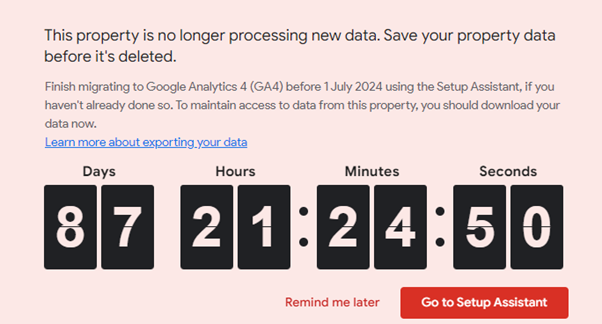In today’s data-driven world, businesses rely heavily on analytics to understand their customers, optimise their marketing campaigns, and drive informed decisions. Universal Analytics (UA) provides a wealth of data on website traffic and user behaviour.
On the 1st of July of 2024 users won’t be able to access any UA properties or the API, and all its data will be deleted. Google is currently prompting Analytics users to export their data before this date through pop-ups in properties and via email. The deadline to save historic website data is the same for both standard and GA 360 users.
Storing and analysing large volumes of UA data can be challenging, and this is where data warehousing comes into play. As well as avoiding the loss of essential information for reporting, the process of storing and transforming Analytics data alongside other data sources can be seen as an opportunity for creating a centralised data environment that can have long-term benefits for measurement and insights.
UA data warehousing involves the extraction, transformation, and loading (ETL) of UA data into a central repository, known as a data warehouse. This warehouse also usually consolidates and organises data from various sources, enabling businesses to analyse it more efficiently and effectively.
Unlike traditional databases, which are designed for operational purposes, data warehouses are optimised for analytical queries and reporting.
There are several key benefits to warehousing UA data:
Implementing a data warehouse involves several key steps:
The cost of UA data warehousing varies depending on the chosen solution, the volume of data, and the number of users.
For example, BigQuery (Google’s own cloud data warehouse) employs a usage-based pricing model, where you pay for the storage and processing of your data. Space & Time offer data warehousing support via BigQuery with access to the final data tables/project for you to either connect to a BI tool of your choosing or have a dashboard created to interface with the data.
Prices depend on your UA data storage needs and visualisation requirements and any other sources that may be involved in wider storage, transformation and reporting projects.
To ensure the success of a data warehouse implementation, it is essential to adhere to best practices such as:
The recommended retention period for UA data depends on the specific business requirements. However, it’s generally advisable to retain data for at least 2 years to gain meaningful insights and identify trends.
This will depend on a few factors. In terms of what can be exported, this will depend on your data retention setting – which can be anywhere between 14 months to unlimited (the default is 26 months). The latest date your Universal Analytics has data for will be subject to when it stopped collecting data when UA sunsetted in favour of GA4.
This is possible into Google Sheets or Excel, but bear in mind there is a limit of 5,000 rows per export, which can soon be reached if breaking data down by multiple dimensions such as data, page, source and medium. There will also be potential issues with merging or connecting data to other sources, especially if you have a high volume of data that is spread over multiple exports.
A single export into a data warehouse (e.g BigQuery) would make it easier to view and analyse data – examples of this would be collecting combinations of products into common product group names or grouping landing pages together to see data by business area or geographic regions (whatever your page structure allows for).
UA data warehousing is essential for businesses looking to unlock deeper, longer-term insights from their website traffic and user behaviour. By storing and analysing UA data in a centralised repository, businesses can improve their reporting and analysis capabilities, enhance data quality, and gain a competitive advantage in the data-driven marketplace.
Space & Time offers a variety of packages ranging from simple UA data warehousing through to broader data architecture and visualisation support. If storing and analysing data is in your business interests, get in touch with technology@spaceandtime.co.uk to talk about how we can help you take a step in the right direction.